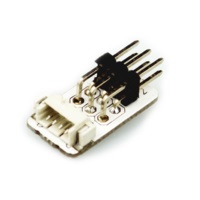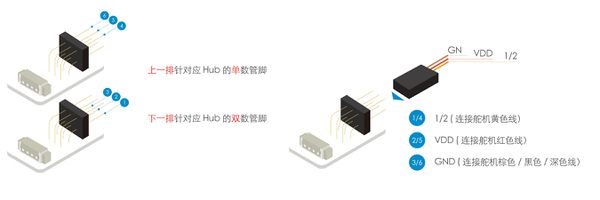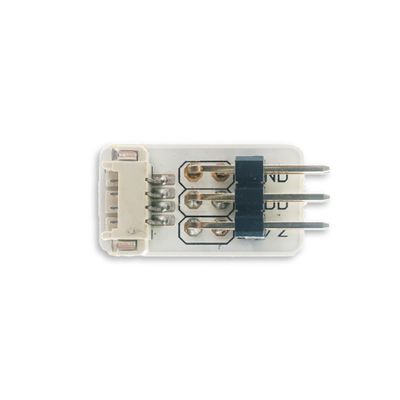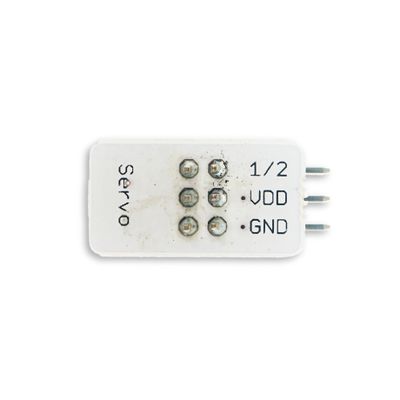“Sensor-Servo Connector/zh”的版本间的差异
502748957@qq.com(讨论 | 贡献) |
502748957@qq.com(讨论 | 贡献) |
||
| (未显示2个用户的3个中间版本) | |||
| 第28行: | 第28行: | ||
<p style="color: #333333;font-size:155%">'''接线说明'''</p> | <p style="color: #333333;font-size:155%">'''接线说明'''</p> | ||
*舵机没法直接和扩展模块(Hub)连接,需要借助舵机转接板。舵机转接板上下各有3个插针,可以同时转接两个舵机。 | *舵机没法直接和扩展模块(Hub)连接,需要借助舵机转接板。舵机转接板上下各有3个插针,可以同时转接两个舵机。 | ||
| + | *舵机线序为 信号线(黄色),电源线(红色),地线(棕色/深色线) | ||
*舵机接线方法如下图所示,舵机线头有金属露出的部分向上为正确接插方法。 | *舵机接线方法如下图所示,舵机线头有金属露出的部分向上为正确接插方法。 | ||
*图中连接SensorHub的D8/D9接口 | *图中连接SensorHub的D8/D9接口 | ||
[[File:舵机板接线.jpg|500px|thumb|center|图中两组排针,上排对应D9,下排对应D8]] | [[File:舵机板接线.jpg|500px|thumb|center|图中两组排针,上排对应D9,下排对应D8]] | ||
[[File:anywhere_Servo-Servo Connector.jpg|600px|center]] | [[File:anywhere_Servo-Servo Connector.jpg|600px|center]] | ||
| + | <br> | ||
| + | ---- | ||
| + | <br> | ||
| + | <p style="color: #333333;font-size:155%">'''语法手册'''</p> | ||
| + | *将舵机转接板使用杜邦线接在D8/D9接口 | ||
| + | *将舵机接在下三根排针上,并注意接线方向为金属口向上,此时控制端口为D9 | ||
| + | *该例程的现象为舵机往复缓慢运动 | ||
| + | (若舵机无反应,尝试将舵机从上排接口换至下排接口或反过来) | ||
| + | <source lang="cpp"> | ||
| + | #include <Servo.h> | ||
| + | |||
| + | Servo myservo; // create servo object to control a servo | ||
| + | |||
| + | #define servoPin 9 | ||
| + | int pos = 0; // variable to store the servo position | ||
| + | |||
| + | void setup() | ||
| + | { | ||
| + | myservo.attach(servoPin); // attaches the servo on pin 9 to the servo object | ||
| + | } | ||
| + | |||
| + | void loop() | ||
| + | { | ||
| + | for (pos = 0; pos < 180; pos += 1) // goes from 0 degrees to 180 degrees | ||
| + | { // in steps of 1 degree | ||
| + | myservo.write(pos); // tell servo to go to position in variable 'pos' | ||
| + | delay(15); // waits 15ms for the servo to reach the position | ||
| + | } | ||
| + | for (pos = 180; pos >= 1; pos -= 1) // goes from 180 degrees to 0 degrees | ||
| + | { | ||
| + | myservo.write(pos); // tell servo to go to position in variable 'pos' | ||
| + | delay(15); // waits 15ms for the servo to reach the position | ||
| + | } | ||
| + | } | ||
| + | </source> | ||
<br> | <br> | ||
---- | ---- | ||
| 第59行: | 第95行: | ||
|- | |- | ||
|width="50%" valign="top" align="left"| | |width="50%" valign="top" align="left"| | ||
| − | [[file:Sensor-Servo Connector-F.JPG|thumb|400px|center|Sensor- | + | [[file:Sensor-Servo Connector-F.JPG|thumb|400px|center|Sensor-Servo Connector Front]] |
|width="50%" valign="top" align="left"| | |width="50%" valign="top" align="left"| | ||
| − | [[file: Sensor-Servo Connector-b.JPG|thumb|400px|center|Sensor- | + | [[file: Sensor-Servo Connector-b.JPG|thumb|400px|center|Sensor-Servo Connector Back]] |
|} | |} | ||
2018年11月20日 (二) 10:36的最新版本
| |
|
引脚
|
接线说明
- 舵机没法直接和扩展模块(Hub)连接,需要借助舵机转接板。舵机转接板上下各有3个插针,可以同时转接两个舵机。
- 舵机线序为 信号线(黄色),电源线(红色),地线(棕色/深色线)
- 舵机接线方法如下图所示,舵机线头有金属露出的部分向上为正确接插方法。
- 图中连接SensorHub的D8/D9接口
文件:舵机板接线.jpg
图中两组排针,上排对应D9,下排对应D8
语法手册
- 将舵机转接板使用杜邦线接在D8/D9接口
- 将舵机接在下三根排针上,并注意接线方向为金属口向上,此时控制端口为D9
- 该例程的现象为舵机往复缓慢运动
(若舵机无反应,尝试将舵机从上排接口换至下排接口或反过来)
#include <Servo.h>
Servo myservo; // create servo object to control a servo
#define servoPin 9
int pos = 0; // variable to store the servo position
void setup()
{
myservo.attach(servoPin); // attaches the servo on pin 9 to the servo object
}
void loop()
{
for (pos = 0; pos < 180; pos += 1) // goes from 0 degrees to 180 degrees
{ // in steps of 1 degree
myservo.write(pos); // tell servo to go to position in variable 'pos'
delay(15); // waits 15ms for the servo to reach the position
}
for (pos = 180; pos >= 1; pos -= 1) // goes from 180 degrees to 0 degrees
{
myservo.write(pos); // tell servo to go to position in variable 'pos'
delay(15); // waits 15ms for the servo to reach the position
}
}
示例教程
Q&A
- 如果我手中的舵机转接板与上面图中的不太一样怎么办?我的接线方式是否要改变?
- 如果拿到的舵机转接板的传感器线连接座是立式的,则为上一版舵机转接器。旧版转接器接线如下图所示。
舵机金属露出部分朝下为正确接插方向,并且上方排针对应偶数接口,下方排针对应奇数接口。
文件:旧版舵机转接连线图.jpg
图中所接为D9接口
历史
图库





